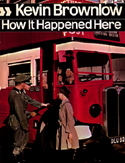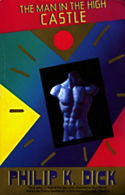| Release List | Reviews | Price Search | Shop | Newsletter | Forum | DVD Giveaways | Blu-Ray/ HD DVD | Advertise |
| Reviews & Columns |
|
Reviews DVD TV on DVD Blu-ray International DVDs Theatrical Reviews by Studio Video Games Features Collector Series DVDs Easter Egg Database Interviews DVD Talk TV DVD Talk Radio Feature Articles Columns Anime Talk DVD Savant HD Talk Horror DVDs Silent DVD
|
DVD Talk Forum |
|
|
| Resources |
|
DVD Price Search Customer Service #'s RCE Info Links |
|
Columns
|
 |
It Happened Here |

|
It Happened Here Image Entertainment 1965 / B&W / 1:37 flat full frame / 96 min. / Street Date February 15, 2000 / 29.99 Starring Pauline Murray, Sebastian Shaw Cinematographer Peter Suschitzky Restored by Kevin Brownlow Directed, Written and Produced by Kevin Brownlow and Andrew Mollo |
Once upon a time, a pair of teenaged English boys decided to make a 16mm war movie with soldiers and guns and lots of excitement. Seven years later it was finally finished, but as a theatrical feature released by a major studio. Director Tony Richardson helped find financing to shoot sequences in 35mm; Stanley Kubrick donated short-ends from Dr. Strangelove to provide the 'youngsters' with film stock.
Called It Happened Here, the result made the rounds of a few European film festivals in early 1965, where it gained a certain amount of notoriety. The story of an England defeated by Hitler and functioning under Nazi rule, it confused and incensed many British critics. They were offended by its notion that the noble Brits who withstood the Battle of Britain would ever knuckle under to the Nazis and collaborate with them as shown in the film. And many were made furious by what they perceived was a pro-Nazi, anti-semitic message. The English Nazis in the film are allowed free rein to spout their ugly anti-Jewish rhetoric without being shot dead or immediately contradicted by stalwart patriotic voices, as was standard practice in war movies. The movie disturbs because it is more convincingly real than any big-budget reconstruction of the war years. Only Daily Variety pegged it correctly, in a review from the Mannheim festival, where it was met by booing German viewers. Filmgoers were more accustomed to the kid-glove handling of the 'Nazi problem'. In The Young Lions, young German Marlon Brando anguishes over his soul-rending moral dilemma.

have worried some early risers in London.
Daily Variety called It Happened Here a science-fiction film, which is sort of what it is -- a story of WW2 in the "negative subjunctive". That is, a tale of events which could have happened but did not happen, but if they did happen they might have happened like this. It's actually an alternate reality story, a time-splinter concept commonplace in films now but unheard of then. 1 It Happened Here takes as its springboard the simple idea that Hitler launched an invasion during the Battle of Britain and quickly subdued England. Everything else follows with complete credibility.
The occupation of England is seen through the eyes of Pauline (Pauline Murray), a country nurse fleeing the fighting that has broken out between German troops and resistance partisans. Using Ireland as a base, the Americans and 'loyalist' English guerillas are attempting to re-invade from the West. Pauline witnesses a massacre of civilians. Believeing that the partisans were responsible, she decides like the majority of her countrymen that getting things back to normal is more important than patriotism. "After all," she sighs, "We did lose the war."
Much of London has been bombed out and its inhabitants are split into two factions: a restless mob of unemployed, uncooperative have-nots and those that have chosen to collaborate with the new order. To work and survive Pauline joins the National Socialist puppet political party called the Immediate Action Organization. The clerk that signs her up is hostile and impersonal:
Pauline: "I've decided to join."
Clerk: "We don't accept your decisions. You accept ours."
Pauline soon finds herself worked half to death training as a combat-ready ambulance nurse. Her Immediate Action uniform earns her the hatred of ordinary people in the street. Germans are everywhere, fraternizing with girls, reading optimistic war news from the Nazi publications on the newsstands. The radio alternates between German marches and propaganda bulletins; as part of her party duties Pauline must attend indoctrination lectures extolling the glory of fascism, and torch-lit rallies and funerals where Nazi speakers stir up hatred and rage with Hitler-like tirades.

The radio voices, the lecturers, the rabid Nazi propagandists are all English: the conquering Germans have placed English fascists in positions of authority. This shocked 1966 English audiences accustomed to 'stiff-upper-lip' propaganda. The majority of the populace collaborated immediately and the remainder has no choice but to passively collaborate as well. Democratic ideals and Churchill's patriotic defiance have fallen by the wayside, as if they had been only bitter illusions. The radio voices (and a particularly convincing newsreel) sell the wonders of National Socialism with disturbing confidence -- disturbing because it is the same kind of confident attitude the modern media use to assure us that our own military actions overseas are all in the name of Freedom and Democracy.
Pauline is tainted by association with a suicidal pro-partisan Doctor Fletcher (Sebastian Shaw), Her harsh Immediate Action supervisors eventually exile her to the countryside, to work in a tiny clinic curiously free of oppressive party supervision. That's as much of the spoiler-laden plot as is fit to reveal.
It Happened Here's strength is in its details. The uniforms, the paperwork, the posters on the buses, the patches on the sleeves, the ration cards all look 100% authentic. Its prime creator Kevin Brownlow was a cutting assistant in films and already a cinema history expert that as a child (!) cobbled together a 9mm film reconstruction of Abel Gance's Napoleon from pieces found in film libraries. His military-buff sidekick Andrew Mollo collected uniforms and equipment, mostly German, at flea markets. The pair linked up with a London collector of Nazi arms and vehicles, all stored at his country farm. Begun (after many false starts) as an amateur film shot in two or three-hour spurts on weekends with whoever would cooperate, the movie grew into an ordeal that went on for years. The crazy production enlisted the help of friends that came and went. The filming sessions were full of last-minute improvisations, like pulling German tourists off the streets of London and asking them to don SS Uniforms!

The whole experience is documented in a book by Kevin Brownlow called How it Happened Here. 2 It's difficult to imagine the gangly-looking Brownlow persuading London authorities to let him stage Nazi troopers marching on parade past city landmarks. Apparently fights broke out between the crew and street toughs -- real Teddy Boys roughed up the filmmakers and stole their cameras.
That was nothing compared to the ordeal the boys would be subjected to when the film was finished. Because It Happened Here maintains a documentary distance and refuses to moralize, some reviewers concluded that it condones the attitudes it depicts. Brownlow and Mollo's mature philosophy was to present the premise without editorial comment. They recruited real English fascist hate-mongers to play the collaborating Immediate Action spokespeople, thereby giving the fictional film a 'true' documentary aspect. The main Nazi spokesman (an odious Frank Bennet) composed much of his own dialogue ... he really believes it, and as we watch this moronic Hitler wanna-be venting his hatred for Bolsheviks and Jews, we realize just how commonplace and banal ideological evil can be. It's the most realistic and truthful presentation of the threat ever presented in a 'non-fiction' movie. By staying resolutely neutral, It Happened Here can't be dismissed as propaganda, as can its two close cousins, the pseudo-documentaries Battle of Algiers and Peter Watkins' The War Game.
English and American denial that 'fascism could happen here' is the subject of this great movie. It goes right to the heart of the problem: the victors think they have defeated some monstrous demonized 'other' and that their job is done. In truth, the ugly fascist, racist and totalitarian ideas always existed and still exist everywhere, and not just in Germany. Industry resistance to the film was to be expected since it had the guts to assert the unpopular but logical truth that England would collaborate, just as had France.
Some distributors were impressed by the movie yet wanted no part of its controversy. The ones that understood the message still worried that normal audiences would think the film an endorsement of Naziism. 3 United Artists finally took on Brownlow and Mollo's labor of love, but insisted on the deletion of a six minute non-scripted discussion sequence where the fascists present their vicious philosophy. Image's DVD reinstates this scene.
Never telegraphing their message with position speeches, the young directors also make It Happened Here a lesson in cinematic storytelling. The skill in the direction completely overcomes considerations of budget and the fact that the movie was shot piecemeal over a number of years. There's nothing to apologize for. Without voiceover or expository dialog, we follow nurse Pauline's every action and clearly understand her every reaction. It's a model of great filmmaking by any stretch of the definition.

Kevin Brownlow went on to become a foremost film historian, and is still active making documentaries about movies. His wonderfully detailed interviews on silent films, when few were interested in the subject, recorded the story of those years just in time, before the actual actors and filmmakers of the silent era passed away.
Andrew Mollo's knowledge of military history and costumes quickly earned him work as a technical consultant and costumer on big-budget movies. You'll instantly recognize him as the costume designer for the Star Wars movies. The Lucas connection goes back further. Peter Suschitzky, the cameraman who gave Brownlow's film its Triumph of the Will- styled documentary look, later shot The Empire Strikes Back. And one of the film's few professional actors, Sebastian Shaw, will have many fans wondering where they've seen him before. Shaw plays Anakin Skywalker in Return of the Jedi, glimpsed only for a minute or so when his black Darth Vader helmet is removed. 4
Image's new DVD is a great opportunity for It Happened Here to make the jump from obscurity to at least a 'cult' level of familiarity. Half 16mm and half 35mm, the picture is purposely grainy and high in contrast. It looks far better on the DVD than Savant has ever seen it projected. The still-frame button makes it fun to peruse the mind-boggling detail in the historical reconstruction. Almost any image in the show looks like some 100% authentic shot from a WW2 newsreel or magazine layout. That this was accomplished on such a non-budget is incredible.
The audio is basically clear but some dialogue is difficult to follow. The (sometimes amateur) original sound recording isn't the best and some actors speak in mumbled English dialects. As it is, there's never difficulty in following the story, and appreciating just how well the actors in this 'amateur' film are directed.

The DVD packaging art makes the movie look at first glance like just another wartime documentary. The subtle image of storm troopers marching past Big Ben is not going to 'hook' causal browsers. This is one film that needs explaining, and the copy on the box only touches on its amazing back-story. The great documentarian Kevin Brownlow restored the film for theaters and is listed as the copyright owner on the box, so one might expect more detail on the film.
The new Image disc is a prime example of the good things happening in DVD. Never before seen on tape or laserdisc, It Happened Here can finally be rediscovered. This one really deserves to be more widely seen. Kudos to Image for bringing it out!
On a scale of Excellent, Good, Fair, and Poor, It Happened Here rates:
Movie: Excellent
Video: Good
Sound: Good -
Supplements: none
Packaging: Snapper case
Reviewed: February 6, 2000
Footnotes:
1. A good example of where the 'negative subjunctive' pops up in a more conventional film is It's a Wonderful Life, where George Bailey is given a taste of what his town might have been like if he had never been born. Think of the  Saturday Night Live skit, 'What if Spartacus had a Piper Cub at that last battle with the Romans?' Think also of the unending exploitative pulp fantasies about WW2 that have bizarre plots where the Nazis win, where the US president is a Nazi, etc. The granddaddy of these is an excellent, visionary non-exploitative book by science fiction author Phillip K. Dick called The Man in the High Castle, which would make a fantastic movie and is recommended one zillion percent by Savant.
Saturday Night Live skit, 'What if Spartacus had a Piper Cub at that last battle with the Romans?' Think also of the unending exploitative pulp fantasies about WW2 that have bizarre plots where the Nazis win, where the US president is a Nazi, etc. The granddaddy of these is an excellent, visionary non-exploitative book by science fiction author Phillip K. Dick called The Man in the High Castle, which would make a fantastic movie and is recommended one zillion percent by Savant.
Return
2. There is also a documentary film made in 1974 called It Happened Here Again. Although Leonard Maltin identifies it as a follow-up to the feature, it is actually a 'making of' for the later Brownlow-Mollo film Winstanley (1975).
Return
3. Modern correlative: Starship Troopers, whose message that our society is developing into a Nazi-like aggression machine, was completely misinterpreted by its audience. (and Paul Verhoeven arguably encouraged the misinterpretation!) Maybe the distributors that turned down It Happened Here were correct: the public at large may be incapable of dealing with ideas more complex than Good Guys versus Bad Guys. Even the oft-touted Battle of Algiers, which similarly affects a documentary style, is less sophisticated: Battle presents both sides but constantly makes liberal comments prejudicial to the Algerian revolutionaries. Brownlow and Mollo's film non-judgmentally depicts an imperfect (collaborating, even) heroine and lets the politics fall where they will.
Return
4. A real tangent: Those of you trying to figure out how George Lucas will make cute little Anakin Skywalker into Big Bad Wolf, I mean, Darth, should check out Doctor Zhivago again. Tom Cortenay's Pasha/Strelnikov character sketches a perfect arc between youthful altruist and scarred inhuman totalitarian monster. He's the most successful part of the Zhivago movie. Come to think of it, it's too bad the movie spends so little time with him. He's more central to the revolutionary theme than the soft-hearted, weak-minded medico played by Omar Sharif. Weirdly, Andrew Mollo was a special consultant on Zhivago.
Return
 Like SCIENCE FICTION? Try the following SAVANT
entries!
Like SCIENCE FICTION? Try the following SAVANT
entries!
Review: IT HAPPENED HERE,
Quatermass and the Pit
The Ultimate INVADERS FROM MARS,
METROPOLIS and STAR WARS,
DUNE and David Lynch,
DANGER: DIABOLIK,
The Uncut THINGS TO COME,
THE ANGRY RED PLANET and CineMagic,
Jump Cut 1 - FORBIDDEN PLANET,
QUATERMASS who?,
An Exotic Treat - THE MYSTERIANS!,
Those ASTRAL COLLISION Movies,
The Strange Case of UNTIL THE END OF THE WORLD.
Review Staff | About DVD Talk | Newsletter Subscribe | Join DVD Talk Forum
Copyright © DVDTalk.com All rights reserved | Privacy Policy | Terms of Use
|
| Release List | Reviews | Price Search | Shop | SUBSCRIBE | Forum | DVD Giveaways | Blu-Ray/ HD DVD | Advertise |





